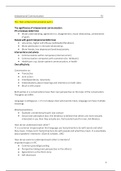Interpersonal Communication P2
HC1: Non-verbal communication part 1
The significance of interpersonal communication
IPC processes determine:
• Mutal understanding, agreement vs. disagreement, mutal relationship, achievement
of goals.
People with good interpersonal skills have:
• Less stress, higher self-efficacy (zelfdoeltreffendheid)
• More satisfaction in intimate relationships
• More friends, less depression/loneliness/anxiety
Interventions and advice
• Communication within companies (internal comm)
• Communication companies with customers (bv. Webcare)
• Healthcare: e.g. doctor-patient communication, e-health
Own effectivity
Conversation as:
• Transactive
• Joint action
• Interdependence, reciprocity
• Interpretations about meanings and intentions on both sides
• Much is left unsaid
Both parties in a conversations have their own perspective on the topic of the conversation.
Thoughts can differ.
Language is ambiguous -> it’s not always clear what words mean, language can have multiple
meanings
Misinterpretations
• Example: unintentional touch/ eye contact
• Sexual over perception bias: the tendency to believe that others are more sexually
interested in you than they actually are. Particularly found for men, link #metoo.
How do we understand each other?
‘It is a common misperception that language use had primarily to do with words and what
they mean. It does not It had primarily to do with people and what they mean. It is essentially
about speakers’ intentions’ (Clark & Schober, 1992
How do we come to understand each other’s intentions?
Important topics in IPC
• Common ground/grounding
• Perspective taking (own perspective vn the others)
• Egocentrism vs the thirst story
• Self-disclosure
1
,How we understand each other’s intentions
• Influence of context
• Influence of the behaviour of conversations parthners
• Influence of the medium
Context heeft grote invloed in hoeverre we gedrag interpreteren.
Context dimensions:
• Set induction
• Physical environment
• Temporal factors
• Social psychological factors ( interpersonal relationship (roles, status, history)
communication history (common ground)
• Culture
• Type of situation (e.g. scripts)
Not ‘what I want, think, mean etc.’ but ‘what does she want, think mean etc.’
Medium determines which (interactive) behaviour is possible, which signals go back and
forth.
Important topics in IPC:
• Constraints and affordances of different media
• Media richness
• Social presence
Purposes of nonverbal communication:
• Replacing, complementing and modifying verbal communication
• Regulating conversations
• Conveying personal and social identity
• Contextualising interaction
• Negotiating relationships
Nonconscious mimicry: do similar thing like the other person -> copying behaviour of the
other person.
Nonverbal mimicry
• Mimicry occurs automatically *unconscious, no awareness, unintentional,
uncontrollable)
• With more mimicry: interaction experienced as more pleasant, interaction partner
judged as nicer.
• Communication accommodation theory: converging vs. diverging.
• Neurological explanation: mirrors neurons -> perceiving an action activates motor
cortex, zien actie -> activeert neuronen die eigen gedrag aansturen.
2
,Nonverbal complementarity
• What happens with power related nonverbal behaviour? (status, dominance)
• Mimicry of complementarity?
• Dominant body posture: taking up a lot of space (postural expansion)
• Submissive body posture: taking up little space, make yourself smaller (postural
constriction)
One dominant, other submissive (=complementarity)
Both dominant of both submissive (=similarity)
With complementarity (opposite posture): interaction experiences as more pleasant, partner
judges as nicer.
With similarity in posture (mimicry) interaction is experienced as relatively unpleasant.
Negotiating hierarchy
• Nonverbal ‘status’ position
Submissive:
Ø Hedges ‘sort of, maybe’, hesitations, tag questions ‘toch?’, higher vocal pitch, low
volume, turn taking: not interrupting, eye gaze: divert.
Nonverbal ‘status’ position
Ø It also depends on personality and context: persons with high vs. low personality
dominance, behave more dominantly (more speaking time) when they are in a low
power position.
Ø Prolong eye contact (vs. gaze aversion): a sign of dominance -> gaze contests
Ø Dispositionally dominant persons ‘automatically lock eyes’ with angry faces.
è Fundamental aspects of interpersonal communication: a model of IPC, interpreataion
and misinterprations, how do ewe unstand each other.
è Nonverbal communication: negotitating elationships.
HC2: Non-verbal communication part 2
First impressions, Facial appearance and social judgment, Categorization, stereotypes and
behaviour, Strategic nonverbal communication, Deception, lying and lie detection Nonverbal
communication: conveying personal and social identity
Leaving an impression on others:
• Often unconscious, unintentional, uncontrollable
• Conscious, strategic use of nonverbal behaviour /signals
Facial appearance
Attractiveness
• Symmetry
• Averageness
• Tests and demos
3
, Facial appearance and social judgment
Attractiveness bias:
• Symmetrical and average (!) face
• Judged as more likeable, socially competent, outgoing, intelligent, healthy.
Halo effect: Initial positive evaluation of a person induces more positive evaluations of other
characteristic
Baby-face bias: round face, large eyes, small jawbones, high forehead, small chin. Reted as
more naïve, sweet, weak, honest, helpless, kind, less competent, less dominant.
• Facial features are linked to judgments of personality
• First impressions are influenced by what a person’ face looks like.
• Judgements are made very quickly (<0.10 sec.). High consensus among judges.
• Our brain categorises faces automatically.
• Perceptions reflect visual stereotypes, not real personality characteristics.
Facial features are not linked to personality, yet some studies suggest some accuracy in
personality judgments from face alone.
Real world consequences: discrimination
Ø More likely to vote for politicians who look competent; to invest in people who look
trustworthy.
Physically attractive:
• Higher grades, more successful when applying for job, lower punishment in lawsuits,
receive help more quickly, more likely elected (politicians)
Baby-face:
• More often innocent in lawsuits, but not when it comes to negligence
è Social categorisation and stereotypes: prejudice and discrimination based on gender,
ethnicity, religion, body, weight etc.
Negative stereotypes have effect on human behaviour: VB: police officer on black lives matter
movement.
• Facial features (e.g. skin colour) activate stereotypes
• Stereotypes subtly influences our interpersonal behaviour
• Mostly outside awareness -> automatic (unconscious, no awareness, unintentional,
uncontrolable)
Ø A first impression can be (mis) leading for how we behave in an interpersonal
interaction.
Strategic nonverbal communication: use NVC to leave a certain impression
4





